Jack Schneider build bamboo fly rods in San Jose, California until his passing in 1952. He, mom and dad, and Jimmie Golden often fished together. Jack’s rods, fly fishing, and Wade Lake, Montana tie us together in my memories. I write about these ties in the article below. They have all passed, mom just last summer, but I have a Schneider rod once owner by Jimmie. It took five years to find it on the market, and it will one day belong to my grandson.
Read about the rod and all it represents here Schneider Rod.
I fished this rod at Wade Lake this last summer, caught fish on a Fledermouse, and scattered mom’s ashes. Soon I will complete the story of the Schneider rod.
Kyuquot bay on the north Pacific side of Vancouver Island was commercial fishing site until it was fished out. Now it is the home of the Rugged Point Lodge Owned by Matt and Kristy Guiquet. They provide ocean fishing through the summer, but in the Fall it’s fly rods on the rivers.

There are places, I hear, where salmon fishing is cast and catch on big crowded rivers, but not Kyuquot. There the rivers are small, wind through the remaining old growth timber on the island, and uncrowded. We saw one other fisherman in four days. The area is now a National Preserve. Matt allows fly fishing only with barbless hooks, and it’s catch and release. These rivers are carefully managed to bring back the historic salmon population. The surrounding area is First Nation (native Indian) land, and it is these people who provide much of the guiding and lodge staff.
Kyuquot is not next door. It takes two days the get there from Denver; the first day to fly to the city of Vancouver, and the second to fly to Cambell River followed by a three to four hour drive to Far Harbor and a thirty minute boat ride to the lodge. Each morning a twenty minute boat run gets you to one or two Zodiacs and an exciting ride up the river to the beginning of the day’s fishing. Along the way it is common to spot whales, eagles, and black bears, but it’s fish that you are after.
The season determines the fish in the river. Kings are in earlier, followed by Silvers and Chums. A few Stealhead are in the mix, but not many. Our trip late in the season found Silvers and Chums in good quantities. Fishing these rivers reminds you of trout fishing. You have to work for your catch, getting the fly to the fish, and executing a good retrieve. Ten to fifteen salmon landed a day is good.
My first Silver took the fly at the end of a fifty foot cast. I had let the weighted fly sink for a eight second count, and begun a steady fast retrieve. Strikes aren’t hard hits like you sometimes experience with a Brown taking a streamer. The line stops or becomes heave. Set the hook, and work to get the slack line through the guides without any tangles. Then watch the line rip off your reel. These fish are real rod benders. Salmon are tough. Some have the energy to swim 900 miles to the Salmon river in Idaho. The Silver on my line was only a mile from the ocean and ready to go one-on-one. I worked the fish to the bank at least three times before it could be netted, but in the end, I prevailed. That was not always the outcome.
The Silvers seemed to be in the six to twelve pound range and Chums about twice that size. They are different fish. A Silver will run, upstream, down, and across. Some you will never see until close to shore, and others will jump. I landed one that jumped eight or ten times. Seemed like it spent more time out of the water than in. Chums tend to want to get back to where they were, and will pull like hell to do so. Catch a couple of these, and you shake your arm hoping it doesn’t cramp.
I foul hooked several Chums, but no Silver. Paul, one of the guides, explained that the Chums stay close to the bottom, while the Silvers ride higher. I was dragging my fly over their backs. It doesn’t take long before you resist snagging another Chum. My first was hooked in the tail and took a very long time to land. The fish had all the advantage.
Gear doesn’t need to be special, just strong. I fished two Elkkhorn nine weights and a vintage Wright-McGill fiberglass. Reels need a good drag. Lines are two or three hundred grain shooting heads, and flies are Flashaboo on a weighted hook. “Throwing” a shooting head is different than casting a dry. It’s not hard, but you need to adjust your technique. Matt watched my cast and tried my Elkhorn Traveler rod. He wanted to know where to get one.
Finally with all the fishing, catching, and bear sighting there are times when you drop the rod tip and look. The clear water, big timber, white clouds, and tall mountains just grab you. The remoteness, the beauty, the fish, wildlife, and water are an extraordinary package that I often paused to observe.
Five of us went to the Big Horn, just north of Wyoming in Montana, and fished the river for thirteen miles down stream of Fort Smith. The first day I waded the river while the others fished with guides. The second two days we all fished from two drift boats without guides. This was my first trip to the Big Horn.
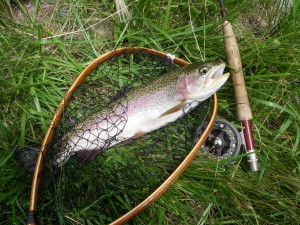 Big Horn Rainbow The river ran at 2400 cfs, which is low. Fishing started at 7 or 8am, but catching started at 9am and slowed down at 2pm. Gray and white sow bugs (Ray Charles), Pheasant Tails, and Rainbow Warriors where the fishes fly of choice. They had to be fished on the bottom, in the current, and preferably at the very head of a hole. Fish were in the fast moving slick water above holes and along the banks, but bottom grass made these spots hard to fish.
In contrast to the Gray Reef in Wyoming, the Big Horn is a float and stop river. We fished from the boat until a good spot was sited, then we landed and fished from shore. Almost all of my fish were caught while wading, and most of Mikes were caught from the boat — what’s with that? Montana is a fishing friendly state where the river is public within the normal high water lines. In Wyoming and Colorado a fisherman can’t touch private land or river bottom. That’s why the Reef is a float through river.
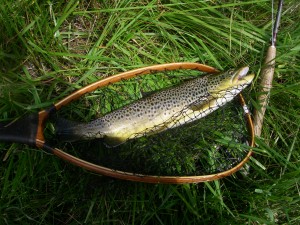 Big Horn Rainbows and Browns are mostly 14 to 18 inches, or 10 inches. It’s good that there is a smaller class, or the river would have no future. These fish are heavy for their length and strong fighters. The Rainbows may go up or down stream, or in the air. I even had a Brown jump and tail-walk, very unusual. By the way, I landed about fifteen fish a day with roughly one third being 10 inchers. I found it necessary change both weight and indicator position to stay on the bottom in differing water. Find the fish, stay on the bottom, and fly selection were the orders of the day. Big Horn Rainbows and Browns are mostly 14 to 18 inches, or 10 inches. It’s good that there is a smaller class, or the river would have no future. These fish are heavy for their length and strong fighters. The Rainbows may go up or down stream, or in the air. I even had a Brown jump and tail-walk, very unusual. By the way, I landed about fifteen fish a day with roughly one third being 10 inchers. I found it necessary change both weight and indicator position to stay on the bottom in differing water. Find the fish, stay on the bottom, and fly selection were the orders of the day.
Nymphs were the money fly, but Darrel and Bruce came upon a very local PMD hatch. For a short time they were catching fish on drys. Bruce also had good luck with streamers in the afternoon. I’m looking forward to a streamer fishing lesson.
This trip was also my first experience rowing a drift boat. I did fine, even through the Big Horn Rapid. It’s all about positioning and control. The rower must place the fisherman in position to fish the best run, and then control the boat so that he achieves a good presentation (drift) through the run. Running the rapids required picking a good path and keeping the boat from turning sideways. It’s good to miss rocks too.
Now the hilarious event, I wish I could have seen it from the shore. I rowed Mike to fast slick water along a tree covered bank and said, “The fish are there, make the cast.” He did and hooked a good fish. I soon realized that if I couldn’t anchor the boat, he would have to play the fish through the upcoming rapid. I rowed to the least current and dropped the anchor. It didn’t hold. We went through the rapid, not white water, dragging the anchor and Mike’s fish. My plan was to row out of the current, but the anchor was dragging and the fish was under the left oar. I had only one oar in the water. Somehow Mike landed the fish, I was able to raise the anchor, and get us ashore. Don’t do that unless you want to look like a novice.
I’ll go back to the Big Horn, it’s a great fishery and fun to fish.
Jim Tilmant and I fished the 8 Rivers Rodeo for the second time this year. It’s a laid back, fun competitive event that donates the proceeds to charity. The rules are simple. Each person of a two person team must catch one fish each in each of eight rivers over the two days. This qualifies the team for awards, which are based on the total length of the sixteen fish. If a person chooses not to record the first fish they land on a river, they must record the second. If your team can qualify, then size matters.
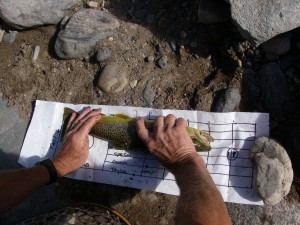 17.5 inch Brown on the Colorado The organizers set the order in which a team fishes rivers. We fished the Crystal, Colorado, Roaring Fork, and Frying Pan on Friday in the Carbondale area. The Colorado was the challenge because it was muddy from the previous night’s storm. Jim suggested we try the mouth of Grizzly Creek in hope of finding clear water. We found a little, caught our two fish, and were thankful.
On the Fork we both hooked and lost big fish, but Jim did land a 19.5 inch White Fish — they count. The emotions of the event are interesting. I was catching my fish early and of reasonable size. Jim was following and had to accept a seven inch fish on the Colorado. This put the pressure on him. I watched Jim fish the Fork for well over an hour after I had recorded my fish and he had lost a Rainbow too big to land in the current. My thoughts were, If not for the fish god, it would be me instead of him trying to get the last fish, and tomorrow it may be. It wasn’t an easy time for either of us.
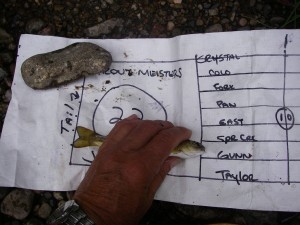 6 Inch Rainbow on the Gunnison Saturday we fished the East, Spring Creek, Gunnison, and Taylor, all in the Almont area. On the Taylor Jim didn’t record his first fish, a 12 inch Brown. The Taylor is known for large fish, and he had booked a 7 incher the previous day. Remember, size counts. He later had to record a 9 inch fish.
I was fishing the Gunnison when Jim came down stream saying he had just caught two 12 inch fish, and had found a hot spot along with the right fly. We went up to his honey hole, and sure enough I quickly hooked a large fish, but failed to land it. Within several more casts I hooked another. It provided a completely different story. Over fifteen minutes of effort the fish took me a hundred yards down stream in the current. When it finally came to the bank, Jim was waiting with his net. The fish rolled on its side a foot from Jim’s net. We had it. No, the hook came out and we didn’t have it. I said, “Oh darn.” Jim said it was a Rainbow, at least 24 inches. He guided in Montana and knows a 24 inch fish when he sees one. Aside from Salmon and Steelhead, it was the biggest river fish I have hooked. I later recorded a 6 inch Rainbow.
The 24 incher would have put us in third place. As it was, we finished seventh out of twelve that qualified. Thirty two teams competed. What did I learn from a competition like this. There is the experience of fishing different water — bigger rivers in my case. But, mostly I learned confidence. We went to eight new rivers in someone’s home water and caught fish. By the way, Jim and I qualified last year too.
Honholz is a small lake 2.5 hours from home. It’s about two hours from anywhere, and this may account for the quality of fish. You can count on it being windy, and you have to fish from a boat or float tube. Wind and float tubes are not friends. It has wadeable shallows (fish be there), but the bottom is very sticky mud under the grass. If you loose your balance, you can’t move your foot to recover. So, Dale and I were float tubing in the wind.
 Female Cutthroat I saw a few Callibaetis mayflies on the surface, but no fish rising. Nymphs seemed to be the fly of choice. I started stripping a Pheasant Tail behind a large black Copper John. Neither two inch strips and pause or longer strips produced a strike. I changed to a olive green Hare’s Ear in place of the PT, and hooked a cutthroat within several casts. The Cutts in Honholz are 12 to 18 inches or 4 to 6. I was in the big fish region, and soon landed a second. These guys are real rod benders and don’t quit fighting until you wonder if they ever will.
Dale was a ways off, but when he could hear I shouted, “Use green. It’s the hot color.” For me it was a 24 fish day, but I learned that Dale only landed six. He said he had many strikes, but couldn’t hook them. I had few strikes that I didn’t hook. There is a lesson here. Dale fished a floating line and dry fly with the nymph on a dropper. I used an intermediate sinking line with the two nymphs. My theory (engineers can have those) is that I had a straight line from the rod tip to the fly. I keep the tip close to the water to assure a tight line with this setup. Dale had a straight line to the dry, and then an angle down to the nymph. The dry dropper rig required pulling the angle out of the line before much of a hook set could occur. The intermediate line is perfect for fishing the top four feet of water and moving the fly parallel to the surface, while keeping the line tight. The pauses in the retrieve give the fly a forward — sink — forward action. It was perfect for the day.
 Is it a Brown or Cutthroat?
It should be easy, and it was except for the hard part. I set out Friday to catch all four trout species (Rainbow, Brown, Brook, and Cutthroat) in the Big Thompson drainage. The Rainbows came from the Big T below Estes Park, the Brookies and Cuttroats from Rocky Mountain National Park, and the Brown from both. The Cutthrots are Greenbacks, a recovering sub-species, are only found on the east slope of the Rockies in Colorado. In the Big T and Park these fish are all wild.
I started where Rainbows are found in the Big T, but they wouldn’t hit until 9 AM. Four were quickly netted, and I moved upstream to a Brown location and landed one quickly. I was going to be done by noon. Fall River flows out of the Park into the Big T, and Roaring River flows into the Fall. Roaring contains Greenbacks. The river drops 800 feet over half a mile to the Fall River. I expected to hike up the canyon and fish the plunge pools, but the water was too high and not fishable. I got my Greenbacks after hiking the entire canyon, and then took the 1.5 mile trail back down.
Fall River meanders through the valley and is a classic Brook Trout stream. After crossing the valley to get away from the fish-by-the-road folks, I was able to catch only Browns — nice ones up to 12 inches. At the junction with Roaring River I caught more Cutts. Why did I hike up that canyon? No Brookies yet. I moved upstream into the willows and started over. Here I found Brook Trout, but scattered. This is a stream that seems ideal for a large fish population, but holds few. Typically hundreds of four to six inch Brookies should be seen. On the other hand, the ones I did catch were eight to ten inches.
Catching four species was easy. Hiking seven miles was hard. Next time I will try a different spot for the Brookies. What I would really like to do is find Rainbows in the Park.
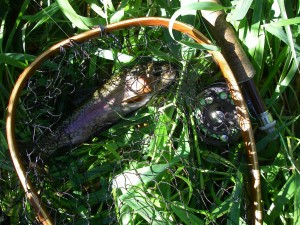 Rainbow  Brook Trout  Brown 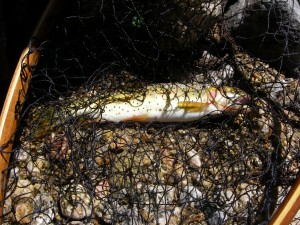 Greenback
Here is the PDF of the Fly Fishing seminar.
Fly-Fishing-For-Rocky-Mountain-TroutLR
Addendum: Important Safety Rule: Wear a belt around the waist of your waders. I take this for granted and didn’t mention it in the seminar, but if you fall in, you don’t want your waders to fill with water. This is equally important in a river, boat, or wading a lake. Lakes often have muddy sticky bottoms along the shore. Imagine your feet stuck while standing in two feet of water. A gust of wind throws you off balance, you fall over, and your waders fill full of water. Do you see a problem here? Wear the belt.
It was a father-daughter thing, secondary
to a fishing thing, when Cody and I fished the Gray Reef Monday and Tuesday. The Reef is a section of the North Platte River up stream from Casper Wyoming. It’s an extraordinary Rainbow fishery. This is spawning season, and every bit of water less than four feet deep without muddy bottom is crowded with Reds (spawning beds). The 15 inch plus trout can be seen on the beds. This is true of the entire eight miles we floated. The Reef is a floating river because the surrounding land is private. You can float, but you can’t touch bottom. There is one stretch of public access that is closed during spawning.
We fished with Pet Mott (TroutTrickers), a guide new to me, but one that Cody had fished with several times on the Colorado and Roaring Fork in Colorado. Pet is a master with his boat. He knows the water, fish, and their behavior. Pet kept us on fish, and we hooked over thirty Monday and twenty-six on Tuesday. Three quarters were boated, and only three were less than fifteen inches. A half dozen were twenty plus inches. Cody out fished me on Monday, but I held even on Tuesday. I told Pet, “If you are fishing with Cody, you have to be on your game to be in the game.”
The game in Wyoming is governed by the weather and the fish. Pet fished in a snow storm on Sunday. We had flurries on Monday, and clear sky on Tuesday. 80 mph gusts were predicted for Wednesday. Pet described fishing the Reef as technical. That means presentation is everything. The fly has to be at the right depth, where the fish are, and without drag.
We drifted flies under a strike indicator. I watched the indicator to assure that it floated with the foam and bubbles. I knew the distance between the indicator and the fly line, and tried to assure that the gap I saw in the water was less than the known distance. It’s an interesting partnership floating with a guide. The fisherman manages the drift and watches for often very light strikes. The guide can watch the river, so you hear, “cast left, cast right, mend your line, Cody you’re in too close, Jim you’re out too far.” Success is measured by fish in the net and learning.
We fished two rigs, deep and shallow, with split shot under the indicator and two or three flies after the shot. The smallest nymph is on the end. I am never less than amazed at the size of fish size of fish, five or six pounds, that will hit a fly 3/8 of an inch long — and we landed them. Did I mention what flies we used? Perhaps I won’t.
Added note, 29 April: fish population in 2009 was 1200 trout per mile. This is down from 2008 at 2100 trout per mile. The loss is due to spawning failure in 2007. There is further detail at http://gf.state.wy.us/services/news/pressreleases/10/02/16/100216_1.asp.
|
|











